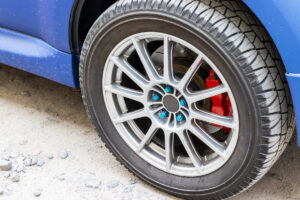Subaru’s Symmetrical All-Wheel Drive (AWD) System is an engineering triumph that seamlessly blends traction and performance.
Subaru’s Symmetrical AWD System is a full-time four-wheel drive system with a longitudinally mounted boxer engine and a symmetrical drivetrain with equal-length half-axles. This design allows for better balance, traction, and stability than traditional AWD systems adapted from front-wheel or rear-wheel drive layouts.
This article will explore the mechanics behind Subaru’s AWD technology, weigh its pros and cons compared to other systems, and discuss some common issues.

How Subaru’s Symmetrical All-Wheel Drive Works
The Symmetrical All-Wheel Drive (AWD) System from Subaru is a leading automotive technology that has earned the brand a reputation for stability, traction, and performance.
This AWD system is engineered to deliver power to all four wheels with a balanced distribution, ensuring consistent grip and control in various driving conditions.
It distinguishes itself with its utilization of a longitudinally-mounted boxer engine configuration. This setup ensures a straight-line power flow through a center differential or a viscous coupling, evenly distributing torque between the front and rear axles or varying it according to the road conditions. The system’s symmetry in power delivery promotes stable handling, improved traction, and responsive performance.
For those who enjoy the outdoors and adventurous activities, the Symmetrical AWD System offers benefits that align with their interests. It delivers reliable traction on slippery or uneven surfaces, making it suitable for both city driving and off-road escapades. It also improves fuel efficiency and reduces emissions by minimizing drivetrain losses.
The system’s stability also contributes to confident handling, which is crucial when navigating twisty roads or challenging terrains.
Whether navigating snowy mountains or city streets, Subaru’s Symmetrical AWD System enhances your driving experience, ensuring that every journey is safe and enjoyable.
For a more in-depth explanation, check out this video by Driving Sports TV:
Subaru’s Symmetrical AWD vs. Other Systems
To give you an idea of whether Subaru’s symmetrical AWD is worth it, let’s look at some pros and cons compared to traditional drivetrains:
Pros
Optimal Traction
Subaru’s Symmetrical AWD system provides optimal traction across various driving conditions.
Delivering power uniformly to all four wheels ensures exceptional grip on diverse surfaces and weather scenarios, surpassing the effectiveness of many competitor systems.
For instance, in comparison with Audi’s Quattro AWD system, which often employs a front-wheel bias and engages rear-wheel drive only when slip is detected, Subaru’s Symmetrical AWD stands out for its consistent power distribution to all wheels.
This feature grants Subaru vehicles an edge in maintaining stability and traction, particularly in scenarios where Audi’s Quattro might be transitioning power between axles. Subaru’s commitment to symmetrical power distribution underscores its dedication to providing superior control and confidence, which can be especially critical in challenging driving conditions.
Stable Handling
The inherent symmetrical power distribution of Subaru’s system offers a unique advantage over non-symmetrical AWD systems from other brands.
This leads to stable and predictable handling, a characteristic that might be absent in some competing models.
Responsive Performance
Subaru’s Symmetrical AWD boasts quick and balanced power transfer between the axles, enhancing agility and maneuverability.
This sets it apart from some traditional AWD systems that might exhibit slower response times.
Off-Road Mastery
Compared to conventional front-wheel-drive (FWD) and rear-wheel-drive (RWD) setups, Subaru’s Symmetrical AWD excels off-road by providing superior traction and control.
Enhanced Safety
The Symmetrical AWD System’s consistent power delivery contributes to heightened safety, particularly in adverse weather conditions.
Cons
Slight Fuel Efficiency Impact
Like most AWD systems, Subaru’s Symmetrical AWD incurs a minor reduction in fuel efficiency compared to front-wheel-drive (FWD) and rear-wheel-drive (RWD) setups.
The additional components and resistance contribute to this trade-off, a common consideration across all AWD systems.
Potential Cost and Repair Complexity
Subaru’s Symmetrical AWD system is meticulously engineered, which can result in higher initial costs and potentially more intricate repair procedures compared to simpler FWD or RWD systems.
Specialized knowledge and parts might be required for maintenance and repairs, giving the system a level of exclusivity.
Subaru’s Symmetrical AWD Has Its Roots in the WRC
Subaru’s Symmetrical AWD System has deep-seated roots that can be traced back to the thrilling world of rallying, most notably the World Rally Championship (WRC). While it wasn’t initially developed exclusively for rally racing, it gained significant refinement and enhancement through Subaru’s participation in the WRC, which began in 1980.
Subaru’s Symmetrical AWD emerged as a formidable competitive advantage in the demanding arena of the WRC, where vehicles are pushed to their limits on treacherous terrains and challenging conditions.
The system’s hallmark is its consistent power distribution to all wheels, which played a pivotal role in conquering the varied surfaces of gravel-strewn tracks, icy roads, and rain-soaked courses.
The insights gained, and successes achieved on the rally circuits significantly contributed to the evolution of the Symmetrical AWD System for Subaru’s production vehicles.
Subaru’s commitment to delivering performance inspired by motorsports is evident in the synergy between rally tracks and everyday roads exemplified through its STI brand.
For enthusiasts and drivers who cherish the legacy of rally racing, it’s worth acknowledging that every Subaru equipped with the Symmetrical AWD System carries a piece of the brand’s rally heritage.
This lineage translates into elevated stability, enhanced traction, and unwavering confidence during their daily journeys, a legacy that resonates from rally racing to suburban streets.

Common Issues With Subaru’s AWD System
Subaru’s Symmetrical AWD System is renowned for its reliability and performance, but like any complex automotive technology, it’s essential to be aware of potential issues that can arise over time.
Here are a few common concerns to keep in mind, along with some possible causes and solutions
1. Maintenance Requirements
Regular maintenance is essential for optimal AWD system performance. This involves inspecting and lubricating components like the transfer case, center differential, driveshaft, and CV joints.
These components facilitate power transfer and require upkeep to prevent friction and wear.
Follow manufacturer recommendations for maintenance type and frequency.
2. Uneven Tire Wear
Maintain tire uniformity to support AWD system balance. As power distribution is uniform, replace all four tires simultaneously to avoid strain and diminished performance.
Mismatched tire sizes or wear can disrupt equilibrium, impacting fuel efficiency and causing noise. Regular tire rotation also prevents uneven wear and extends tire lifespan.
3. Noise and Vibration
Unusual noises or vibrations during acceleration or turns may signal AWD system issues. Promptly diagnose and address these symptoms to prevent complications.
Worn CV joints, damaged driveshafts, or faulty center differentials can cause noise and vibration. CV joints link the driveshaft to the wheels, driveshafts transmit power, and center differentials regulate wheel speed.
4. Leaking Fluids
Fluid leaks near the transfer case or differential can lead to inadequate lubrication and potential damage. Regularly inspect for leaks as these fluids reduce friction and heat.
Leaks cause overheating, corrosion, and wear. Address leaks promptly to prevent extensive repairs and avoid ground stains or odors.
5. Dashboard Warning Lights
Modern Subaru vehicles employ diagnostics to detect AWD-related issues. Dashboard warning lights like AT Oil Temp or Vehicle Dynamics Control indicate concerns.
These lights relate to transmission fluid overheating and stability control problems.
Malfunctions affect gear shifting, power transfer, and vehicle stability, necessitating professional inspection.
6. Center Differential Binding
In specific scenarios like tight turns on dry surfaces, the center differential might bind due to wheel speed differences. This creates resistance or shuddering during acceleration or turns. The issue can be managed by driving on less demanding surfaces, like wet roads.
Some models offer a manual switch to adjust the center differential for traction or maneuverability.
7. Complex Repairs
Subaru’s AWD system durability is undeniable, yet repairs can be intricate compared to simpler drivetrains.
Specialized knowledge and authentic parts are crucial for precise diagnosis and repair.
Complex repairs might involve the center differential clutch pump replacement due to fluid leaks or the entire transmission unit replacement, which can be time-consuming and costly.
Prioritize proper maintenance and timely issue resolution to prevent significant repairs.
Final Verdict
Subaru’s Symmetrical AWD System is an exceptional example of automotive innovation and performance. Its ability to provide superior balance, traction, and stability on any terrain elevates it beyond conventional AWD systems.
While there may be minor concerns regarding maintenance and repair, the advantages this system brings to the driving experience are undeniable. As a legacy of rally-inspired engineering, this system is not just technology but a steadfast companion that enhances every journey.



